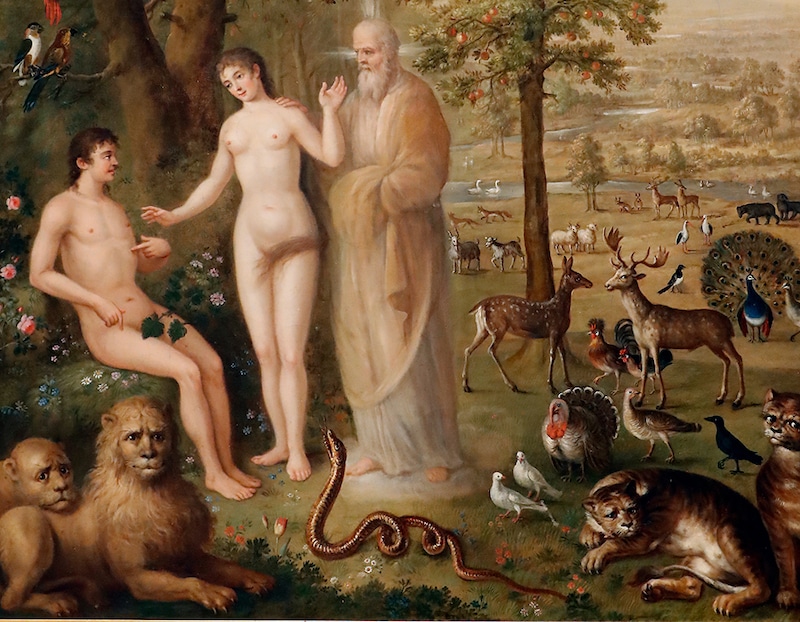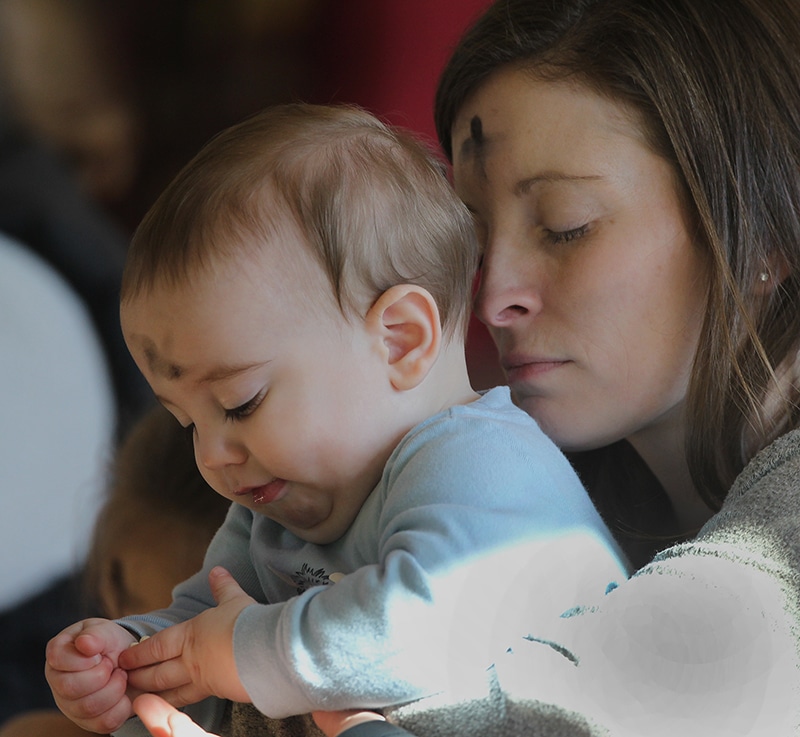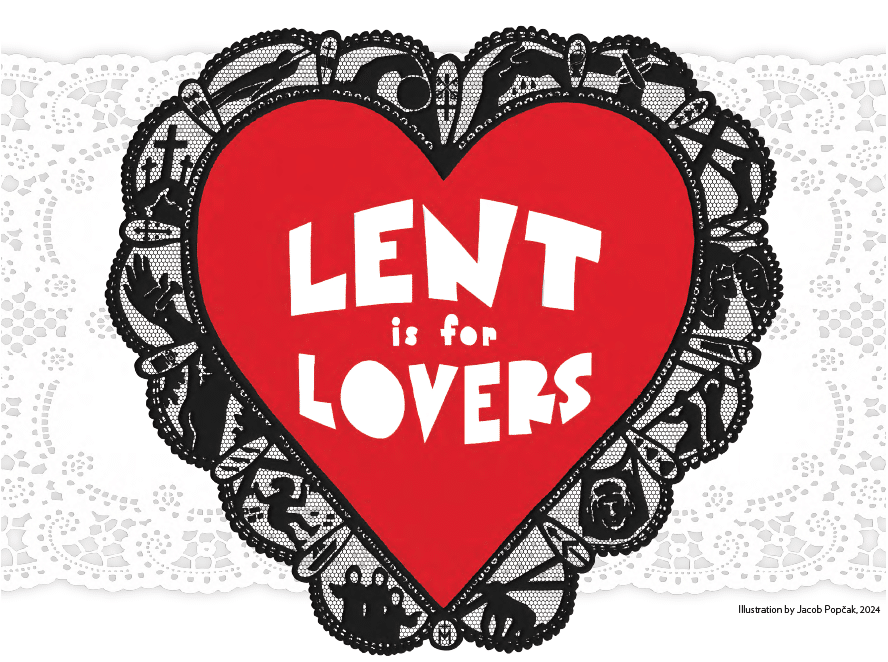“I was once asked by a newspaper to write down a thought for Valentine’s Day,” wrote the British Catholic author Alice Thomas Ellis. “I wrote, ‘Men love women, women love children, children love hamsters, and hamsters don’t love anybody.'” Now call me unsentimental, but that’s a motto I’d far rather see embroidered on a throw pillow than “Live Laugh Love.” There is always something oddly mismatched about love, even when people are trying their best. Men love women differently than women love men, parents love their children differently than children love their parents, and children have the charmingly vexing tendency to pour out their love on things that will never love them back, like stuffed animals, blankets and rodents.
This Valentine’s Day puts the mismatch of love right at the center of attention, because Feb. 14, 2024, happens also to be that Date Night-favorite holiday, Ash Wednesday. Fish, fasting and #Ashtags don’t exactly match with candies, candlelight and #ValentinesVibes, and I doubt that you’ll find a chalky Valentine’s heart emblazoned with “ASH 2 ASH” or “I FAST 4 U” no matter how hard you look. But that’s a shame, really, because the very awkwardness of these two days overlapping points out how closely they’re related. Together, Valentine’s Day and Ash Wednesday tell us that the mismatch of love is not an accident, but our path to heaven.
Mismatched loves
For Christians, it’s hardly news that love is a combination of different things that can seem contradictory. A seventh-century hymn in honor of the Virgin Mary can find no better way to praise her than to sing of the paradoxes of the Incarnation: “The God whom earth, and sea, and sky / adore, and laud, and magnify, / who o’er their threefold fabric reigns, / the Virgin’s spotless womb contains.” The Virgin holds in her own body the God whom the whole universe cannot hold, who himself holds all creation in being, and who as the eternal, unchanging, all-powerful Word is born a helpless baby in Bethlehem — and all that is contained in the cheery winter greeting “Merry Christmas.” Christian things have a way of being bigger on the inside than they are on the outside, and of revealing the deepest meanings when things seem at first mismatched.

From the very beginning, there was always a mismatch between our love for God and God’s love for us, but in itself that’s actually a good thing. It wasn’t humanly possible even for Adam and Eve to love God the way he loves himself, which was by design. God gave Adam and Eve the freedom to receive his love and his way of loving as a gift, so that the human life of union with God would be the fruit of freedom and not the consequence of necessity. We know all too well what happens next — the tree, the snake, the fruit, the fall — but let’s not gloss over the heart of the problem: Adam and Eve just didn’t want to love that much. They wanted to take what God was offering, they wanted to have it by their own right, through their own action, in their own power, but they didn’t want to receive it as a gift. They preferred to leave the realm of love entirely and wander in the desert of jealousy and power rather than to accept the mismatch between their love and God’s, and to follow where it might lead.
From the very beginning, there was always a mismatch between our love for God and God’s love for us, but in itself that’s actually a good thing.
That’s at the root of why there’s something always slightly off about our love. We live with the wounds of our first parents’ refusal to love, with the accumulated effect of loveless actions over the great span of human time, and most of all with the legacy of every time we’ve said “love” and meant “control.”
Love can be mismatched in two different ways. The mismatch we were made with and made for is an effect of the unrepeatable individuality of each person: I’m who I am, and you’re who you are, and when we are able to love each other well, I learn more about myself and how I’m not you, and also about who you are and how you’re not me. The very best kinds of love are the ones that allow the things that make us different to stay different and, in fact, give them the freedom to grow. It’s only by learning to love like this that I actually learn to see what’s genuinely unique about the other person, and to respect and foster it at all costs.
This is how God loves us. In the perfection of his love, I never stop being me and he never stops being God, but in letting me grow in the way of loving that is proper to me, he lets me become more and more who I am, and at the same time I become by his grace more and more like him. A human being always remains infinitely mismatched with God — we never become his equals or his rivals — but in being willing to acknowledge that fact and receive from God whatever he wants to give us, we are able to respond to him with the beautifully, supernaturally transformed human love that he made us for. And that love is as particular as we are, even when all of us are made holy by the same one Jesus Christ. There is a way of praising God that is yours and yours alone, because you were made to reveal the love of Christ with the whole reality of who you are. This is why St. Elizabeth of the Trinity’s basic spiritual dictum is just three simple words: Let yourself love.
‘Wanna-be love’ and the human heart
In human love, there’s a particular version of this fruitfully mismatched love that we call complementarity, which means in effect that a man and a woman will always be mismatched and will never be exactly the same, but that the way that they’re mismatched makes for a new creativity and generates new possibilities that could never exist in a monochromatic world: namely, the infinitely mismatched, endlessly chaotic and perfectly human gift of children.
But there is another way that love can be mismatched, which never belonged in the world. As an effect of sin, love is marked with all kinds of cruel and altogether usual ways of just not fitting together. Often, it’s my own vision of my love that’s mismatched with my actions and their results. I’m absolutely certain the other person is angry with me, or scheming, or generally up to no good, so I withhold my love, hoping to make up a deficit in love by loving less. Or I’m absolutely certain that I know what’s best for the other person and let myself browbeat, cajole and manipulate until I get my way — all out of love, of course. Or I tell myself I’m acting out of love, but my actions look suspiciously like they’re motivated by jealousy, or anger, or resentment, or self-centeredness, or distraction, or anything but love. There are a thousand versions of this self-deceiving, wanna-be love, each one uglier than the last, but what they have in common is that they take love’s place in the heart, and slowly wear away my ability to recognize the real thing when I see it.
Lent, then, is about finding ways to let the heart want to want God.
Jumping ahead, the great story of our failure to love has an ending happier than the human heart could ever devise. God the Word took our nature, lived in our flesh, loved the Father with God’s own love from within our human heart, died on the cross as an act of perfect love in order to bring about reconciliation between each sinner and God, and rose from the dead in unconquerable majesty, making of his resurrected body the place where we can live eternally in his love.
But the problem is, we’re not there yet. Jesus really did these things, but unless they happen for me and in me, healing my sinful love and forgiving my evil deeds, the whole mystery of the cross and Resurrection is — for me — to no avail. I am the one who, “in my flesh,” must “complete what is lacking in Christ’s afflictions for the sake of his body, that is, the church” (Col 1:24, RSV). I am the one who has to learn to receive the love of God. I am the one who has to learn how to see what’s wrongly mismatched about my love, and let God re-match it to himself.
The purpose of Lent
This is where Lent comes in. Most of us have learned our bad habits and bad ideas of love over a long period of time, so God in his mercy usually gives us the gift of healing from them gradually. The graces of the sacraments, the liturgy, and the life of prayer are of course available all year round, but the 40 days of Lent are a particularly rich time of conversion, precisely because they train the heart to want to accompany Christ in the desert, to look toward his cross, and to long for the Resurrection.
But let’s pause here for a second. What’s so great about the desert? Right after the account of Jesus’ baptism, we hear: “Then Jesus was led by the Spirit into the desert to be tempted by the devil. He fasted for forty days and forty nights, and afterwards he was hungry” (Mt 4:1-2). Christ’s period in the desert is above all a time of suffering — from the heat and desolation of the desert itself, from wild beasts, and of course from the pestering of the devil. Putting it very crassly, this does not sound like my ideal way to spend a weekend, let alone 40 days. So why does the Church invite us to do it every year?

The answer is, of course, love. The wrong ways that we love become all too familiar, so that, after a time, I can’t even see what’s not working anymore. The desert is the perfect antidote, giving us the time and space to learn to love again. Symbolically, a desert is a kind of no-man’s land, a place where no one is at home, where everyone is helpless, where everyone needs to learn how to depend on others in order to survive. So this is what Lent lets us do — step away from our all-too-familiar patterns of broken love and self-deceit, go away from the cozy lives of spiritual idleness we’ve built for ourselves, and walk out into the burning heat of the Son of God.
Prayer — learning to want God
This happens in different ways. Traditionally, the Church has talked about three basic patterns that mark out the way of life in the desert: prayer, fasting and almsgiving. But these are not just another checklist to mark off during the 40 days of Lent — they are ways of inviting God to reveal to us more about ourselves and our lives than is comfortable.
Prayer is the most obvious, but in some ways the most deceptive. Almost any Christian you talk to will say that he or she wants to pray more; and even if not, the person will at least say that he or she should pray more. But if we start thinking about prayer from the point of obligation, then it naturally triggers all my self-defense mechanisms: “I’m so busy, how could anyone possibly ask me to do one more thing? I’m doing everything for God anyway,” and on and on. The problem is, that whole way of thinking is just polishing brass on the Titanic, because if my honest, top-secret, inside-voice response to thinking about spending time talking to God is, “Ugh, this better not take too long,” I’m already trapped in mismatched thinking.
There is a way of praising God that is yours and yours alone, because you were made to reveal the love of Christ with the whole reality of who you are.
The absolutely most fundamental kind of prayer is just wanting God. Just that. I mean it. But because our hearts are tied up in knots, bad habits, strange boredoms and even stranger enthusiasms, we don’t honestly want God very much. So we actually need to learn how to want him, and to learn what it might look like for the longing for God to be the desire that moved all my other wants. Lent, then, is about finding ways to let the heart want to want God.
Learning to desire is a profound experience of the desert, because one of the most basic beliefs we have about ourselves is that our desires are good and right — why else would we desire things? But in searching for the freedom really to desire God, we discover countless reasons why it would be more convenient not to learn that I really would prefer to binge-watch the sixth episode of a mediocre show tonight rather than risk acquiring a desire that would demand more of me. Prayer is desire; but only when God takes all our loves apart and re-assembles them with his own love can desire be free to be prayer.
Fasting — finding freedom
In a world of fad diets, intermittent fasting and detox cleansing, fasting for Lent can seem a bit quaint, as if Catholics haven’t gotten the memo that there’s a great way to Fast, Eat All You Want, and Look Great, Too. And, of course, in a world of eating disorders, body image issues and self-harm, Lenten fasting can seem like a relic of a better-forgotten past. Both of these attitudes make sense on their own terms, but here again they’ve gotten hold of the wrong end of the stick. Fasting is emphatically not about losing weight, or about exerting control over your life through food. It’s about learning how to give our body its true dignity. Speaking boldly of that dignity, St. Bernard of Clairvaux says, “only through the body does the way, the ascent to the life of blessedness, lie open to us.” And only through fasting do we begin to give our body that freedom.
Why? Because everything we do is connected. Our desires have a way of exploding in a thousand different directions at once, like a group of startled bats bursting out of a cave. The best way to start to get them in order is not to let them all fly free, or to desperately try to cram them all into a little cage and pretend they’re under control. It’s to focus on one very small, even petty desire for something that’s good but not necessary to live, which we can willingly choose not to fulfill. That very minor and intentionally artificial discipline has a remarkable effect on the heart, slowly training us to be able to think seriously about what we want, which desires we should satisfy, and when.

Fasting is not about food — in fact, it can involve any of our desires, from steaks to social media. Often when people think about fasting for the first time, they think about not eating for a week or not sleeping for days on end, but that’s just a kind of athletic pride. Real fasts are almost embarrassingly small, like not eating dessert for a week, or not watching TV for a few days, or, in Lent, something so minor that we can sustain feeling its absence for 40 days. Fasting helps us feel in our bodies and in our hearts what a small desire is, how unimportant it is when we don’t fulfill it, and at the same time, just how hard that can be.
Because ultimately, fasting is about love. When we give in more or less automatically to any random desire that comes our way, we’re not free for the truest, deepest kinds of love. Choosing to give up a good thing for a set amount of time helps me to see that I have multiple levels of desire — some small but loud, some large but quiet — and to train even my body itself to learn to want the things that really satisfy, not just what’s available at the moment. Because at its root, every fast has the same point: to let me feel a practical, even physical desire and the small pain of not satisfying it — and to realize that I actually do long for Jesus more than I long to scratch that itch.
Almsgiving — reordering our mismatched loves
“Almsgiving” sounds like it belongs in a Charles Dickens novel, where our well-dressed hero tenderly presses a coin in a rag-clad beggar’s outstretched palm, turning away with a tear in his eye at the suffering in the world. But the reality is something much more basic. In principle, we never have enough of the things we have to spend, especially time and money, which invariably makes us want to hoard them for our own purposes. And at the same time, there are always people whose need for time and money is keener than my own. Almsgiving does two things at once: it curbs my overgrown attachment to my own time and money, and it materially benefits someone who needs one or the other, or both.

Let me be clear: almsgiving is not about ending poverty or eliminating world hunger. It’s about letting God take two wrongly mismatched loves — for my own stuff and for my neighbor — and put them back in good working order.
“As Lent is the time for greater love, listen to Jesus’ thirst. … He knows your weakness. He wants only your love, wants only the chance to love you.”
— St. Teresa of Calcutta
That’s easier said than done. Mother Teresa used to talk about her work as the process of learning to see Christ in the “distressing disguise” of the poor. People who are in need, especially very desperately in need, can be frankly unattractive; physical poverty can make people stink, emotional poverty can make someone needy, spiritual poverty can make someone arrogant, and a poverty of time can make someone crassly self-centered. The very hardest and most beautiful thing about almsgiving is learning not to be scared of unattractiveness, in myself and in others. Only when I have the courage to see the ugliness of my own possessiveness about what I have can I have the courage to see the ugliness of the other person’s neediness, without being repulsed by either. That makes almsgiving above all a matter of internal vision: learning how to see the other person’s dignity, so that I can love what is truest about them, and offer what I have to help foster their growth in truth.
| POPE FRANCIS ON LENT |
|---|
|
In this Lenten season, accepting and living the truth revealed in Christ means, first of all, opening our hearts to God’s word, which the Church passes on from generation to generation. This truth is not an abstract concept reserved for a chosen intelligent few. Instead, it is a message that all of us can receive and understand thanks to the wisdom of a heart open to the grandeur of God, who loves us even before we are aware of it. Christ himself is this truth. By taking on our humanity, even to its very limits, he has made himself the way — demanding, yet open to all — that leads to the fullness of life. Fasting, experienced as a form of self-denial, helps those who undertake it in simplicity of heart to rediscover God’s gift and to recognize that, created in his image and likeness, we find our fulfillment in him. In embracing the experience of poverty, those who fast make themselves poor with the poor and accumulate the treasure of a love both received and shared. In this way, fasting helps us to love God and our neighbour, inasmuch as love, as Saint Thomas Aquinas teaches, is a movement outwards that focuses our attention on others and considers them as one with ourselves (cf. Fratelli Tutti, 93). Lent is a time for believing, for welcoming God into our lives and allowing him to “make his dwelling” among us (cf. Jn 14:23). Fasting involves being freed from all that weighs us down — like consumerism or an excess of information, whether true or false — in order to open the doors of our hearts to the One who comes to us, poor in all things, yet “full of grace and truth” (Jn 1:14): the Son of God our Saviour. — Pope Francis’ message for Lent 2021 |
This Lent, we have the perfect opportunity to learn that Ash Wednesday is not a contradiction of Valentine’s Day; it’s a revelation of its deepest potential. We were made for love, even if we’ve forgotten what it means. Left to their own devices, our sinfully mismatched loves tend to pull us farther away from God and from each other, making us lonelier and more estranged, all in the name of love. Lent is here to remind us that God made our mismatch-ment, so that we could learn to receive everything from him, and become free enough to love one another with the dignity and beauty that belongs to each of us alone. Lent is for lovers. But do I want to love?

